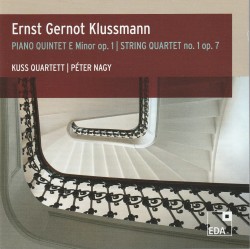 Ernst Gernot Klussmann – Piano Quintet; String Quartet No.1
Ernst Gernot Klussmann – Piano Quintet; String Quartet No.1
Kuss Quartet; Péter Nagy
EDA Records EDA 055 (eda-records.com/177-0-CD-im-Detail.html?cd_id=100)
In the booklet accompanying this first-ever CD devoted to Ernst Gernot Klussmann (1901-1975), Carsten Bock suggests that the neglect of Klussmann’s extensive output in all genres is “due to the stigma attached to artists who worked in Germany during the Nazi era.” Klussmann had joined the Nazi party in 1933 but, insists Bock, he “was anything but a Nazi… a timid person who was careful to observe the rules and laws.”
After listening to these two early works, I submit instead that Klussmann’s “timidity” and “careful observation of the rules” led him to creating music that despite its intrinsic merit is dismissed for too closely imitating the composers he admired – Brahms, Mahler and Schoenberg.
Klaussmann’s Piano Quintet in E Minor, Op.1 (1925) opens with a yearning violin melody that could have been written by Brahms. Brahms reappears in the movement’s tumultuous development and the rhapsodic Adagio molto e cantabile as well as the noble, vigorous anthem and fugal section of the dramatic Finale. This thoroughly enjoyable work might easily have entered the repertoire had it been premiered a generation earlier.
Just a few years later, in his String Quartet No.1, Op.7 (1928-1930), Klussmann abandoned Brahms for the long-lined, chromatic dissonances of Mahler and the Schoenberg of Verklärte Nacht.
Pianist Péter Nagy and the Berlin-based Kuss Quartet make a persuasive case for these substantial works, both over half an hour, both well worth hearing even if you’ve “heard it all before.”



